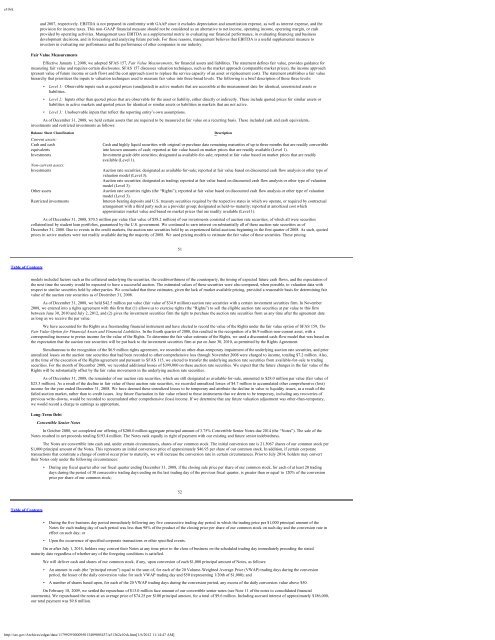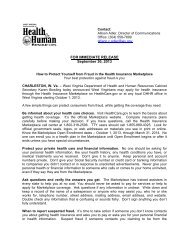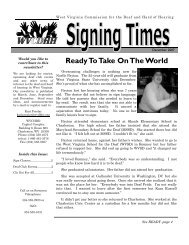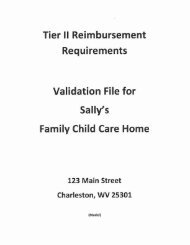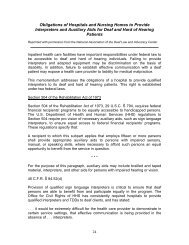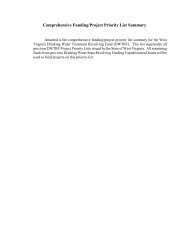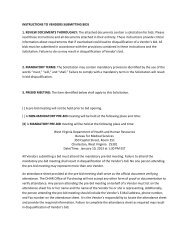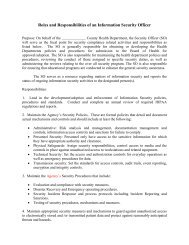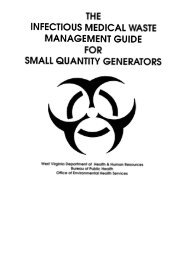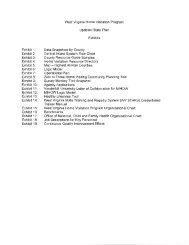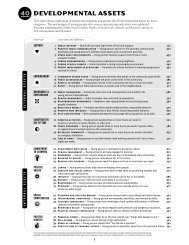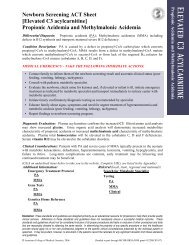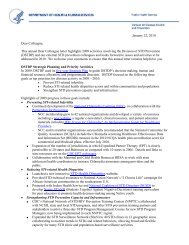Molina Medicaid Solutions - DHHR
Molina Medicaid Solutions - DHHR
Molina Medicaid Solutions - DHHR
You also want an ePaper? Increase the reach of your titles
YUMPU automatically turns print PDFs into web optimized ePapers that Google loves.
e10vkand 2007, respectively. EBITDA is not prepared in conformity with GAAP since it excludes depreciation and amortization expense, as well as interest expense, and theprovision for income taxes. This non-GAAP financial measure should not be considered as an alternative to net income, operating income, operating margin, or cashprovided by operating activities. Management uses EBITDA as a supplemental metric in evaluating our financial performance, in evaluating financing and businessdevelopment decisions, and in forecasting and analyzing future periods. For these reasons, management believes that EBITDA is a useful supplemental measure toinvestors in evaluating our performance and the performance of other companies in our industry.Fair Value MeasurementsEffective January 1, 2008, we adopted SFAS 157, Fair Value Measurements, for financial assets and liabilities. The statement defines fair value, provides guidance formeasuring fair value and requires certain disclosures. SFAS 157 discusses valuation techniques, such as the market approach (comparable market prices), the income approach(present value of future income or cash flow) and the cost approach (cost to replace the service capacity of an asset or replacement cost). The statement establishes a fair valuehierarchy that prioritizes the inputs to valuation techniques used to measure fair value into three broad levels. The following is a brief description of those three levels:• Level 1: Observable inputs such as quoted prices (unadjusted) in active markets that are accessible at the measurement date for identical, unrestricted assets orliabilities.• Level 2: Inputs other than quoted prices that are observable for the asset or liability, either directly or indirectly. These include quoted prices for similar assets orliabilities in active markets and quoted prices for identical or similar assets or liabilities in markets that are not active.• Level 3: Unobservable inputs that reflect the reporting entity’s own assumptions.As of December 31, 2008, we held certain assets that are required to be measured at fair value on a recurring basis. These included cash and cash equivalents,investments and restricted investments as follows:Balance Sheet Classification DescriptionCurrent assets:Cash and cashequivalentsCash and highly liquid securities with original or purchase date remaining maturities of up to three months that are readily convertibleinto known amounts of cash; reported at fair value based on market prices that are readily available (Level 1).InvestmentsInvestment grade debt securities; designated as available-for-sale; reported at fair value based on market prices that are readilyavailable (Level 1).Non-current assets:InvestmentsAuction rate securities; designated as available-for-sale; reported at fair value based on discounted cash flow analysis or other type ofvaluation model (Level 3).Auction rate securities; designated as trading; reported at fair value based on discounted cash flow analysis or other type of valuationmodel (Level 3).Other assetsAuction rate securities rights (the “Rights”); reported at fair value based on discounted cash flow analysis or other type of valuationmodel (Level 3).Restricted investmentsInterest-bearing deposits and U.S. treasury securities required by the respective states in which we operate, or required by contractualarrangement with a third party such as a provider group; designated as held-to-maturity; reported at amortized cost whichapproximates market value and based on market prices that are readily available (Level 1).As of December 31, 2008, $70.5 million par value (fair value of $58.2 million) of our investments consisted of auction rate securities, of which all were securitiescollateralized by student loan portfolios, guaranteed by the U.S. government. We continued to earn interest on substantially all of these auction rate securities as ofDecember 31, 2008. Due to events in the credit markets, the auction rate securities held by us experienced failed auctions beginning in the first quarter of 2008. As such, quotedprices in active markets were not readily available during the majority of 2008. We used pricing models to estimate the fair value of these securities. These pricing51Table of Contentsmodels included factors such as the collateral underlying the securities, the creditworthiness of the counterparty, the timing of expected future cash flows, and the expectation ofthe next time the security would be expected to have a successful auction. The estimated values of these securities were also compared, when possible, to valuation data withrespect to similar securities held by other parties. We concluded that these estimates, given the lack of market available pricing, provided a reasonable basis for determining fairvalue of the auction rate securities as of December 31, 2008.As of December 31, 2008, we held $42.5 million par value (fair value of $34.9 million) auction rate securities with a certain investment securities firm. In November2008, we entered into a rights agreement with this firm that (1) allows us to exercise rights (the “Rights”) to sell the eligible auction rate securities at par value to this firmbetween June 30, 2010 and July 2, 2012, and (2) gives the investment securities firm the right to purchase the auction rate securities from us any time after the agreement dateas long as we receive the par value.We have accounted for the Rights as a freestanding financial instrument and have elected to record the value of the Rights under the fair value option of SFAS 159, TheFair Value Option for Financial Assets and Financial Liabilities. In the fourth quarter of 2008, this resulted in the recognition of a $6.9 million non-current asset, with acorresponding increase to pretax income for the value of the Rights. To determine the fair value estimate of the Rights, we used a discounted cash-flow model that was based onthe expectation that the auction rate securities will be put back to the investment securities firm at par on June 30, 2010, as permitted by the Rights Agreement.Simultaneous to the recognition of the $6.9 million rights agreement, we recorded an other-than-temporary impairment of the underlying auction rate securities, and priorunrealized losses on the auction rate securities that had been recorded to other comprehensive loss through November 2008 were charged to income, totaling $7.2 million. Also,at the time of the execution of the Rights agreement and pursuant to SFAS 115, we elected to transfer the underlying auction rate securities from available-for-sale to tradingsecurities. For the month of December 2008, we recorded additional losses of $399,000 on these auction rate securities. We expect that the future changes in the fair value of theRights will be substantially offset by the fair value movements in the underlying auction rate securities.As of December 31, 2008, the remainder of our auction rate securities, which are still designated as available-for-sale, amounted to $28.0 million par value (fair value of$23.3 million). As a result of the decline in fair value of these auction rate securities, we recorded unrealized losses of $4.7 million to accumulated other comprehensive (loss)income for the year ended December 31, 2008. We have deemed these unrealized losses to be temporary and attribute the decline in value to liquidity issues, as a result of thefailed auction market, rather than to credit issues. Any future fluctuation in fair value related to these instruments that we deem to be temporary, including any recoveries ofprevious write-downs, would be recorded to accumulated other comprehensive (loss) income. If we determine that any future valuation adjustment was other-than-temporary,we would record a charge to earnings as appropriate.Long-Term DebtConvertible Senior NotesIn October 2008, we completed our offering of $200.0 million aggregate principal amount of 3.75% Convertible Senior Notes due 2014 (the “Notes”). The sale of theNotes resulted in net proceeds totaling $193.4 million. The Notes rank equally in right of payment with our existing and future senior indebtedness.The Notes are convertible into cash and, under certain circumstances, shares of our common stock. The initial conversion rate is 21.3067 shares of our common stock per$1,000 principal amount of the Notes. This represents an initial conversion price of approximately $46.93 per share of our common stock. In addition, if certain corporatetransactions that constitute a change of control occur prior to maturity, we will increase the conversion rate in certain circumstances. Prior to July 2014, holders may converttheir Notes only under the following circumstances:• During any fiscal quarter after our fiscal quarter ending December 31, 2008, if the closing sale price per share of our common stock, for each of at least 20 tradingdays during the period of 30 consecutive trading days ending on the last trading day of the previous fiscal quarter, is greater than or equal to 120% of the conversionprice per share of our common stock;52Table of Contents• During the five business day period immediately following any five consecutive trading day period in which the trading price per $1,000 principal amount of theNotes for each trading day of such period was less than 98% of the product of the closing price per share of our common stock on such day and the conversion rate ineffect on such day; or• Upon the occurrence of specified corporate transactions or other specified events.On or after July 1, 2014, holders may convert their Notes at any time prior to the close of business on the scheduled trading day immediately preceding the statedmaturity date regardless of whether any of the foregoing conditions is satisfied.We will deliver cash and shares of our common stock, if any, upon conversion of each $1,000 principal amount of Notes, as follows:• An amount in cash (the “principal return”) equal to the sum of, for each of the 20 Volume-Weighted Average Price (VWAP) trading days during the conversionperiod, the lesser of the daily conversion value for such VWAP trading day and $50 (representing 1/20th of $1,000); and• A number of shares based upon, for each of the 20 VWAP trading days during the conversion period, any excess of the daily conversion value above $50.On February 18, 2009, we settled the repurchase of $13.0 million face amount of our convertible senior notes (see Note 11 of the notes to consolidated financialstatements). We repurchased the notes at an average price of $74.25 per $100 principal amount, for a total of $9.6 million. Including accrued interest of approximately $186,000,our total payment was $9.8 million.http://sec.gov/Archives/edgar/data/1179929/000095013409005437/a51362e10vk.htm[1/6/2012 11:14:47 AM]


